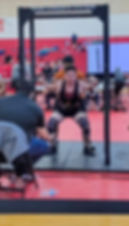Texas youth face barriers to sports participation
- ycastmediagroup
- May 28
- 6 min read
Updated: Sep 12
By Bethel Kifle, Cindy Tiny, Angel Treviño and Lauren Wong
May 28, 2025
Youthcast Media Group®
This story was posted on The Barbed Wire's online publication on June 20, 2025.
In Houston, a city where athletic opportunities can be as uneven as the notoriously bumpy sidewalks, 16-year-old Mallika Mohan knows that passion alone isn’t enough to get into– and stay in– youth sports.

Mallika, a sophomore at Bellaire High School, has been learning ballet and Bharatanatyam, a classical Indian dance, since she was 8 years old. She takes a weekly class at Banbury School of Dance, roughly 10 minutes from her home, where she dances about three hours each week.
Mallika’s parents drive her to classes, and pay for lessons, plus the shoes, costumes and jewelry she needs for performances.
“It’s not an inexpensive sport,” Mallika said. “Pointe shoes cost $100 a pair, and I’ve paid $75 a lesson before at a different studio.”
Mallika knows she’s lucky that her family’s income allows her and her brother to be involved in sports. For many youth in Houston, and across the state of Texas, cost, transportation, neighborhood safety concerns, and time constraints are significant barriers to sports and physical activity.
In 2022, fewer than one-third of youth in families with an income below the federal poverty level (approximately $27,000 for a family of four) participated in sports. This participation increased to 70% in families with incomes of $108,000 or more, according to a data brief from the National Center for Health Statistics.

That’s due in large part to the “pay to play” model that has come to dominate the youth sports landscape, says Eleana Fanaika, executive director of Every Kid Sports, a national non-profit aiming to increase youth sports participation.
“Most youth sports at schools were all free. If you wanted to play, you could play, and you could do as many sports as you want, and the school took care of those fees,” she says. “That's not the case anymore, except for some very few scenarios that still have funding to do so.”
The rise of club and elite teams, and the shriveling of recreational opportunities in many cities has led to a dearth of options for many families, particularly those who have lower incomes. Travel and club team fees can be $2,000 per year, or even higher.
Less than half of youth ages 6-17 in Texas played on a sports team or took lessons in 2022, according to the Aspen Institute’s State of Play 2024 report. That’s far short of the federal government’s goal of getting at least 63% of youth involved in sports by 2030.
Not having access to sports can mean less physical activity for kids. Nearly half of youth aged 12 to 21 are not regularly “vigorously active,” according to the Centers for Disease Control and Prevention. In Texas, nearly 70% of children ages 6-11 are not physically active for an hour a day, according to the National Survey on Children’s Health.
That’s why Every Kid Sports, and other organizations like it in Texas and nationwide, are working to level the playing field when it comes to access to sports and physical activity for kids.
“Everybody deserves that chance to explore the world of sports and all the benefits that come from trying a sport,” Fanaika said. “Learning to show up on time, failure, defeat, and sorrow when you try to win something, these [experiences are] really good. I wish that for everybody.”
Barriers to youth sports high for many
Another contributing factor to low participation in physical activity among young people is the increased competitiveness in sports. Youthcast Media Group recently surveyed 85 youth nationwide about the barriers to sports access and physical activities in their cities. Of the 57.6% of youth who said they quit a sport, 35% stated that the reason for quitting was because their sport got too competitive or “not fun.”
Not only do a lot of youth end up quitting sports; they tend to do it before they even reach their teen years. “The average child spends less than three years playing a sport and quits by age 11, usually due to lack of enjoyment,’’ according to The Aspen Institute’s State of Play report, a national review of trends and developments in youth sports.
This competitive sports landscape is a recent one, which Fanaika, of Every Kids Sports, attributes to more parents wanting to increase their children’s chances of making it to the pros.
“It piggybacks off trying to get your kid to be the best, and some kids are going to get cut,” Fanaika said.
When it comes to sports and physical activity, being able to show up and put in effort is one of the core aspects of working out. Unfortunately, some youth say they are shut out of physical activity due to their most limited resource: time. Youth say they have to manage school, sleep, their personal life, and extracurricular activities, often leading them to have to sacrifice something to maintain balance.

Roberto Salinas, a senior at Jimmy Carter Early College High School in La Joya, experienced the dilemma firsthand.
“I quit powerlifting after my junior year because I wanted to pursue more academic extracurricular activities,’’ Salinas said. His burgeoning love of the sport lost out to a longstanding commitment to journalism.
When time is a precious commodity, barriers like distance and needing to take a bus, can make getting to sports impractical.
In Houston, geography alone can be a significant challenge for many youth who want to participate in sports or even basic activities. “Transportation has definitely been like a big issue throughout my life with trying to get to ballet studios,” Mallika, the sophomore at Bellaire, said. “Because a lot of the time, they're really far away from where I live.”
For families living outside of affluent neighborhoods like West University or Southside Place, which have neatly kept parks, local sports facilities, and easy access to enrichment programs, the challenge of getting to a ballet class, soccer field, or even a clean public park can be overwhelming.
“You could drive a long time without ever seeing a park,” Mallika said, pointing out the stark contrast between underserved neighborhoods and wealthier enclaves.
Lharissa Jacobs, founder and executive director of Fit Houston, a nonprofit that increases free physical activity across Houston, sees this inequity as a moral issue. “This is an unacceptable reality for children to be living in this situation,” Jacobs said. “They need to be able to visit their park.”
Jacobs and Fit Houston are working to raise awareness citywide through a solution they see as accessible to all. Through its #WALK30 initiative, the organization promotes a simple yet powerful idea: walking (or moving) for 30 minutes a day. The campaign grows out of a larger mission “to inspire vibrant minds, bodies, and communities through physical activity.”
The need for help getting kids active is high in Houston, and across Texas. Since its national launch in 2020, Every Kid Sports has awarded more than $2 million to pay registration fees in 30 sports for more than 15,000 kids, according to the organization. That included 3,787 Houston children awarded more than $541,000.
To be sure, organizations like Fit Houston and Every Kid Sports that tackle one piece of the problem can only have so much impact — Every Kid Sports had to turn away more than 12,000 Texas kids since their launch due to lack of funding. The leaders of both groups hope that their work will inspire others, including nonprofits, community businesses and government leaders, to step in and help as well.
When Every Kid Sports started covering registration fees for one baseball team in San Antonio, the team was able to focus on fundraising and partnerships in the community, Fanaika said, which allowed for the construction of a new field for players.

Although the road to youth sports equity is long, Jacobs and Fanaika argue it’s an important goal.
“The long-term health benefits are too immense to ignore,” Jacobs said. “In the short term, physical activity can improve mood and anxiety. In the long term, it can actually positively impact depression, and of course, it reduces the risk for Alzheimer's and other brain conditions.’’
Meanwhile, Fanaika’s push to remove cost as a barrier to sports and consistent physical activity for youth is personal. “I want to give back because it's made me who I am,’’ she said. It (physical activity) drives me every day.”
Youth like Mallika are also cheering and championing a more barrier-free world. “Sports are an equalizer,’’ she says. “I think that we should provide this opportunity to all kids.”
Bethel Kifle and Cindy Tint are sophomores at Bellaire High School in Bellaire, Texas, Angel Trevino is a senior at Jimmy Carter Early College High School in Mission, Texas and Lauren Wong is a junior at Brooklyn Technical High School in Queens, New York. They were participants in a feature writing workshop with Youthcast Media Group and worked with mentor Nichole Christian on this story.
